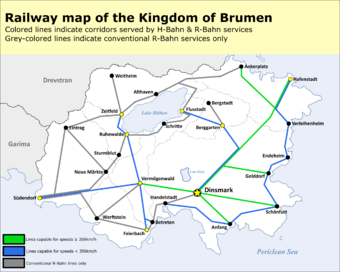Realm Railway Group of Brumen: Difference between revisions
No edit summary |
mNo edit summary |
||
| Line 13: | Line 13: | ||
* Sano Sokudo (Chief Executive Officer) | * Sano Sokudo (Chief Executive Officer) | ||
| assets = | | assets = | ||
| revenue = {{increase}} $ | | revenue = {{increase}} $XXX | ||
| net_income = {{increase}} $ | | net_income = {{increase}} $XXX | ||
| subsid = [[RGB West]] <br> [[RGB East]] <br> [[RGB North]] <br> [[RGB South]] <br> [[RGB Care]] <br> [[RGB Property]] | | subsid = [[RGB West]] <br> [[RGB East]] <br> [[RGB North]] <br> [[RGB South]] <br> [[RGB Care]] <br> [[RGB Property]] | ||
| num_employees = | | num_employees = XX,XXX | ||
| owner = {{flagicon image|Flag_of_Brumen.png}} [[Government of Brumen]] [[(Department of Infrastructure & Transportation)]] | | owner = {{flagicon image|Flag_of_Brumen.png}} [[Government of Brumen]] [[(Department of Infrastructure & Transportation)]] | ||
}} | }} | ||
| Line 23: | Line 23: | ||
|logo_filename = RGB_Logo.png | |logo_filename = RGB_Logo.png | ||
|logo_size = 200px | |logo_size = 200px | ||
|system_map = | |system_map = RGB_Network_Map.png | ||
|map_caption = Map of Brumen's rail network. | |map_caption = Map of Brumen's rail network. | ||
|map_size = | |map_size = | ||
Revision as of 05:35, 3 July 2022
This article is incomplete because it is pending further input from participants, or it is a work-in-progress by one author. Please comment on this article's talk page to share your input, comments and questions. Note: To contribute to this article, you may need to seek help from the author(s) of this page. |
 Logo used since January 1958 | |
Formerly | Brumen Rail (1930 - 1958) Waldreich Rail Company (1844 - 1930) |
|---|---|
| State Owned Company | |
| Traded as | FSX: RGBN |
Key people |
|
| Revenue | |
| Owner | |
Number of employees | XX,XXX |
| Subsidiaries | RGB West RGB East RGB North RGB South RGB Care RGB Property |
 | |
 Map of Brumen's rail network. | |
 A H-Bahn Blitz 3 train. | |
| Locale | |
|---|---|
| Dates of operation | 1844–present |
| Predecessor | Brumen Rail (1930 - 1958) Waldreich Rail Company (1844 - 1930) |
| Track gauge | 1,435 mm (4 ft 8 1⁄2 in) Standard Gauge |
| Length | 97,000 km (60,000 mi) |
| Headquarters | Dinsmark, Brumen |
The Realm Railway Group of Brumen (Brumenese: Reichsbahngruppe Brumen), commonly abbreviated as RGB, is a for-profit national state-owned railway company & operator in Brumen consisting of six subsidiaries. The Government of Brumen is the largest shareholder, holding 55% of the company's shares whereas the remaining 45% are publicly traded in the Anfang Stock Exchange. RGB maintains and administers the country's rail network and operates a fleet of train services through its subsidiary companies, operating both fleets of high speed (HSR) and conventional (non-HSR) rail services. Generally speaking, all high speed services in Brummen are referred to as the H-Bahn, whereas conventional rail services include the R-Bahn, U-Bahn & S-Bahn networks. Other services provided by RGB includes regional, commuter, rapid-transit & light rail networks. RGB Freight provides logistical & freight services for Brumen's industries whereas RGB Care provides maintenance for both its fleet of trains & infrastructure including tracks, stations & crossings. All major cities in Brumen are connected by both H-Bahn & R-Bahn services whereas smaller towns and cities are connected by R-Bahn services supplemented by U-Bahn & S-Bahn services for local services.
History
Early History
Decentralized Era
Privatization of Railway
Controversy & Bankruptcy
Consolidation & Nationalization
Company Structure
Services
H-Bahn
The H-Bahn (abbreviation of Hochgeschwindigkeitszug Bahn) is the name of all Highspeed Rail services provided by RGB in Brumen. The H-Bahn is found in all RGB's subsidiaries and is generally its most profitable business units. The first H-Bahn network commenced operations in 1970 along the Dinsmark-Flusstadt rail corridor, which at the time was the busiest and most congested rail corridor in Brumen, was an immediate success. Ridership during its maiden trip was high and the service was able to maintain relatively consistent daily ridership levels. Highspeed Rail became a topic of national discussion, its popularity surged exponentially prompting the RGB to propose multiple expansion plans which were approved by the federal government. Both federal & private loans made by the RGB were approved and each of its subsidiaries soon began construction of their own H-Bahn lines. By 1974 all subsidiaries of RGB had at least one H-Bahn corridor in active service. During its infancy however the H-Bahn proposal was met with fierce resistance, mostly from automobile lobby groups who feared that the implementation of a rapid transit system would lead to a decline in automobile ownership. Politicians who were endorsed by these lobby groups became the most vocal opponents of the H-Bahn network, calling for an end of federal funding for the RGB's H-Bahn expansion programs. Opponents of the H-Bahn argued that the H-Bahn is not entitled to receive both federal & state funding and its continued funding should be derived from the RGBs' own revenues. Eventually in 1975 lawmakers in both Congress and Conclave of the Bundeskammern held public hearings for adoption of the H-Bahn network with all H-Bahn expansions put on hold. In spite of these roadblocks however public support for the H-Bahn and RGB skyrocketed, mostly drive due to the efficiency and convenience delivered by H-Bahn services. Eventually proponents of the H-Bahn in Congress & Conclave prevailed which cemented the H-Bahn as a strategic component of the country's public transportation network, guaranteeing its continued access to government funding on the federal & state levels.
R-Bahn
The R-Bahnm (abbreviation of Regionalbahn) is the umbrella term for all conventional (non-HSR) services operated by RGB. Because of this it is often considered as a hybrid train service that combines the characteristics of inter-city, local and commuter train services. It is also the only type of train service whose fare is partially subsidized by the government. When combined together, R-Bahn services represents the largest ridership and source of revenue of RGB and its subsidiaries. While H-Bahns enjoy a higher popularity amongst commuters due to its rapid service time it is more expensive and not everyone uses the H-Bahn on a daily basis. Most daily commuters would utilize various R-Bahn services to commute from their houses to work. H-Bahn networks are primarily used for commuters who live and work in two different cities, a smaller demographic compared to the rest of the workforce who typically live either within the same city or its suburbs and then commutes to the center of the city using an R-Bahn service. R-Bahns have been a pivotal part of RGB since the establishment of the modern railway era, and continues remains so in the present day. Modern R-Bahn trains are much faster and accommodate more passengers compared to those made in the early 2000s. The demographics of commuters have also shifted, previously before 2000 the largest user of hte R-Bahn service were the lower class of society due to its subsidized fares. However in modern times more people from the middle class have begun to utilize the R-Bahns, citing its increased reliability, quality of service & its cheap fares. The middle and lower class have become the two largest users of R-Bahn services, with a small bug significant number of upper class of society also utilizing it. There are however calls from within the government and the general public to end government subsidies for R-Bahn fares. Proponents for ending subsidy argues that subsidized fares were implemented during times of economic downturn of Brumen, whereas in the modern era most people including the lower class can afford to pay for non-subsidized R-Bahn fares. Opponents on the other hand argue that the government is bound by the country's constitution to provide subsidies, quoting article 15 of the constitution that states the government is obligated to provide a means for the country's population access to affordable public transportation. The debate continues to date.
U-Bahn
S-Bahn
Subsidiaries
| Business | Company Name | Logo | Operational Area | Remarks |
|---|---|---|---|---|
| Passenger | RGB West |  |
Largest subsidiary of RGB, operates the largest fleet of H-Bahn trains. | |
| Passenger | RGB North |  |
||
| Passenger | RGB East |  |
||
| Passenger | RGB South |  |
||
| Logistics | RGB Freight |  |
||
| Maintenance Services | RGB Care |  |
Networks
Assets
Rolling Stock
| Train Class | Image | Origin | Entered Service | Line | Power Type | Speed | Remarks | ||
|---|---|---|---|---|---|---|---|---|---|
| H-Bahn | |||||||||
| Blitz 4 |  |
2015 | TBD | Electric | 420 km/h (Record) 400 km/h (Design) 380 km/h (service) |
Used for long distance services | |||
| Blitz 3 |  |
1999 | TBD | Electric | 330 km/h (Design) 300 km/h (service) |
Used for long distance services | |||
| R-Bahn | |||||||||
| REX-5 |  |
2011 | TBD | Electric | 290 km/h (Record) 220 km/h (Design) 130 km/h (service) |
Used for medium & long distance services | |||
| REX-4C |  |
2002 | TBD | Electric | 160 km/h (Design) 90 km/h (service) |
Used for short & medium distance services | |||
| REX-4B |  |
2002 | TBD | Electric | 160 km/h (Design) 90 km/h (service) |
Used for medium & long distance services | |||
| REX-4A |  |
2001 | TBD | Electric | 160 km/h (Design) 70 km/h (service) |
Used for medium & long distance services | |||